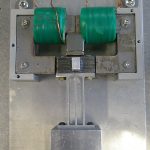
SpecTrackular2024 - 2027
This project aims to develop an optical telescope system capable of spectroscopic analysis of space debris. In order to achieve the high-precision telescope pointing and tracking required for this application, a self-learning pointing model and an improvement of orbit prediction based on obtained data will be developed. Ultimately, spectroscopic analysis can give information on the material, pose and rotation of space debris. Read more →

AdLaS – Adaptive mounting system with powerless gravity compensation for mirror segments in large telescopes2023 - 2024
Vibration isolation is indispensable in many high-precision applications, both in industry and research. Since the stringent requirements cannot be met by purely passive systems, a suspension system for heavy loads with a levitating platform, active vibration suppression and integrated gravity compensation was developed in this project. Read more →

Research and Flight Test of Advanced Turbulence Cancelling Technologies for Sustainable Urban and Regional Air Mobility (SmartWings2)2023 - 2026
The SmartWings2 project aims enhanced turbulence load suppression (TLS) via new sensor technologies of wind lidar and distributed MEMS turbulence sensing, as well as a novel flaplet. The predecessor project SmartWings successfully demonstrated TLS in light aircraft by means of turbulence probes in front of the wing and actuation of predefleced flaps for direct lift control. Read more →

BioBuzz2023 - 2027
In this cooperation project together with University of Vienna, approaches of pollination biology and flower evolution are combined with mechatronic methods in order to investigate how Melastomataceae flowers have adapted to vibration pollinating bees. For this, a vibration system is desigend in order to execute artificial, bee-like flower vibration experiments. Furthermore, the mechanical properties of the flowers are explored by vibration experiments in the lab and the internal flower structure is obtained by computer tomography. With this, the bio mechanics of flowers can be modelled and simulated. Read more →

MobileSpectro2022 - 2025
Infrared spectroscopy is a fundamental technique for the characterization and analysis of chemical compounds. MobileSpectro aims to develop a miniaturized high precision FTIR spectrometer that enables handheld operation for field use and provides a performance comparable to lab-based instruments. Read more →

ConvoyFence2021 - 2024
This project aims at the development and integration of a vibration isolation platform with the main target application of optical drone identification systems in mobile scenarios. It will be integrated into existing vehicles to provide early and effective information for the protection of convoys against UAV threats. Read more →

High-speed large format 3D printing
To overcome the speed limitation of stereolithography 3D printers in this project, a polygon mirror based light engine is developed, which enables a laser line scan speed of a few hundred meters per second. Read more →

Precision robotic in-line metrology for freeform surfaces
High precision in-line measurements on free form surfaces are considered as a key factor for future industrial production. Robot-based measurement systems enable the required flexibility but are typically lacking the required precision. The scope of this project is the development of a measurement platform as end effector for a robot robot arm, carrying a measurement tool and compensating for environmental disturbances, enabling precision inline measurements. Read more →

Hybrid reluctance actuators for high precision motion
Next-generation high-quality motion systems require high-precision actuators with higher energy efficiency and larger force to improve the system throughput. Particularly, actuators with a motor constant higher than comparable voice coil actuators are highly desired. This project investigates hybrid reluctance actuators (HRAs) with guiding flexures as a promising candidate of next-generation systems. Read more →

Active Turbulence Suppression for Aircraft – SmartWings
Atmospheric turbulence is an unsolved problem for aviation. By investigating smart wing structures, which sense turbulence and actively reject disturbances by flap deflections, it shall become possible to fly through turbulence in a direct and reliable way in the future. Read more →